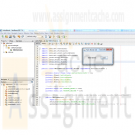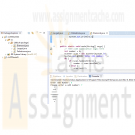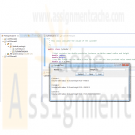Search results for 'CIS-130 Relational Database Management - M4E 2013'
-

PRG 421 Week 1 Hello World Program
$8.00PRG 421 Week 1 Hello World Program
Learn More
Design, implement, test, and debug a GUI-based version of a “Hello, World!” program.
Create a JFrame that includes a JLabel that reads “Hello, World!” Use a layout manager of your choice.
Include an Exit button to close the program.
Submit the .java source file. -

PRG 421 Week 3 Contact Information Program
$15.00PRG 421 Week 3 Contact Information Program
Learn More
This is a two-part assignment.
Part 1
Design, implement, test, and debug a program with a JFrame that allows the user to enter a series of contacts’ names, ages, e-mail addresses, and cell phone numbers, and creates a file from the entered data. Validate the age entry to ensure that it is numeric and between 0 and 120. Include information for three to five contacts.
Part 2
Design, implement, test, and debug a program that reads the file you created by the list in Part 1 and displays the records in a JFrame. You may either display all entries in the list at once or display them one at a time; the user interface is up to you. Protect against not being able to open the file.
Submit the .java source files. -

PRG 421 Week 3 Learning Team Fundraiser Initial program
$12.00Learning Team Instructions Fundraiser Program
Learn More
A city is sponsoring a run to support local charities and would like an application to track the pledges. The result will be a database that holds data on individuals, total pledges obtained, and the charity for which the donation is designated.
Design and implement a GUI-based program to accept a participant’s name, the amount pledged, and the designated charity’s name. The program will store these data for later retrieval.
PRG 421 Week 3 Learning Team Initial program
Create a GUI-based program to accept name of donor, name of charity, and amount of pledge from the user.
Display a list of entries in a JTextArea or JTable.
Submit the .java source file for this program. -

PRG 421 Week 4 Learning Team Fundraiser Program Instructions Add a Data File
$12.00Learning Team Instructions Fundraiser Program
Learn More
A city is sponsoring a run to support local charities and would like an application to track the pledges. The result will be a database that holds data on individuals, total pledges obtained, and the charity for which the donation is designated.
Design and implement a GUI-based program to accept a participant’s name, the amount pledged, and the designated charity’s name. The program will store these data for later retrieval.
PRG 421 Week 4 Learning Team Instructions Add a Data File
Modify the program you created in Week Three to write the data—name, amount, and charity—into a sequential data file.
Implement a capability of reading what is in the existing data file and displaying it in the text area.
Submit the .java source file for the program. -

PRG 421 Week 5 Learning Team Fundraiser Program Connect to a Database
$15.00Learning Team Instructions Fundraiser Program
Learn More
A city is sponsoring a run to support local charities and would like an application to track the pledges. The result will be a database that holds data on individuals, total pledges obtained, and the charity for which the donation is designated.
Design and implement a GUI-based program to accept a participant’s name, the amount pledged, and the designated charity’s name. The program will store these data for later retrieval.
PRG 421 Week 5 Learning Team Connect to a Database
Write a program to create a database from the data in the sequential file you created in Week Four.
Modify the GUI to connect to this database and add entries to it and read entries from it. Entries read from the database should be displayed in the JTextArea or JTable.
Test and debug this final program.
Submit the .java source file or files. -

PRG 420 Week 2 Simple Commission Calculation Program Part 1
$15.00PRG 420 Week 2 Simple Commission Calculation Program Part 1
Learn More
Write a Java™ application using NetBeans™ Integrated Development Environment (IDE) that calculates the total annual compensation of a salesperson. Either a GUI graphic user interface) program or non-GUI program is acceptable. Consider the following factors:
• A salesperson will earn a fixed annual salary of $25,000.00.
• A salesperson will also receive a commission as a sales incentive. Commission is a percentage of the salesperson’s annual sales. The current commission is 10% of total sales.
• The total annual compensation is the fixed salary plus the commission earned.
The Java™ application should meet these technical requirements:
Create a NetBeans project and name it XXXIA2. XXX is your last name. It is important to use your last name so that each student’s project name is unique. When your team evaluation the members’ program, the team will know whom the program belong to. Your system can also load in multiple projects without conflicting project names. The number 2 in the file name is the academic week number.
• The application should have at least one class, in addition to the application’s controlling class (a controlling class is where the main function resides).
• There should be proper documentation in the source code.
• The application should ask the user to enter annual sales, and it should display the total annual compensation.
Because NetBeans produces multiple files for one project, the best method to submit an assignment is to zip the files. There should be one project folder created by NetBeans using your project name. Zip the folder. Submit your NetBeans project zip file. -

PRG 420 Week 3 Simple Commission Calculation Program Part 2
$15.00PRG 420 Week 3 Simple Commission Calculation Program Part 2
Learn More
Modify the Week Two Java™ application using Java™ NetBeans™ IDE to meet these additional and changed business requirements. Either a GUI (graphic user interface) program or non-GUI program is acceptable.
• The company has recently changed its total annual compensation policy to improve sales.
• A salesperson will continue to earn a fixed salary of $25,000.00. The current sales target for every salesperson is $120,000.
• The sales incentive will only start when 80% of the sales target is met. The current commission is 10% of total sales.
• If a salesperson exceeds the sales target, the commission will increase based on an acceleration factor. The acceleration factor is 1.25 which means all sales above the sales target will be earning 25% commission.
• The application should ask the user to enter annual sales, and it should display the total annual compensation.
• The application should also display a table of potential total annual compensation that the salesperson could have earned, in $5000 increments above the salesperson’s annual sales, until it reaches 50% above the salesperson’s annual sales.
Sample Table: Assuming a total annual sales of $100,000, the table would look like this:
Total Sales Total Compensation
100,000 <<Program calculated value>>
105,000 <<Program calculated value>>
110,000 <<Program calculated value>>
115,000 <<Program calculated value>>
120,000 <<Program calculated value>>
125,000 <<Program calculated value>>
130,000 <<Program calculated value>>
135,000 <<Program calculated value>>
140,000 <<Program calculated value>>
145,000 <<Program calculated value>>
150,000 <<Program calculated value>>
The Java™ application should also meet these technical requirements:
Create a NetBeans project and name it XXXIA3. XXX is your last name. It is important to use your last name so that each student’s project name is unique. When your team evaluation the members’ program, the team will know whom the program belong to. Your system can also load in multiple projects without conflicting project names. The number 3 in the file name is the academic week number.
• The application should have at least one class, in addition to the application’s controlling class.
• The source code must demonstrate the use of conditional and looping structures.
• There should be proper documentation in the source code.
Because NetBeans produces multiple files for one project, the best method to submit an assignment is to zip the files. There should be one project folder created by NetBeans using your project name. Zip the folder. Submit your NetBeans project zip file. -

PRG 420 Week 4 Simple Commission Calculation Program Part 3
$15.00PRG 420 Week 4 Simple Commission Calculation Program Part 3
Learn More
Modify the Week Three Java™ application using Java™ NetBeans™ IDE to meet these additional and changed business requirements. Either a GUI (graphic user interface) program or non-GUI program is acceptable.
• The application will now compare the total annual compensation of at least two salespersons.
• It will calculate the additional amount of sales that each salesperson must achieve to match or exceed the higher of the two earners.
• The application should ask for the name of each salesperson being compared.
The Java™ application should also meet these technical requirements:
Create a NetBeans project and name it XXXIA4. XXX is your last name. It is important to use your last name so that each student’s project name is unique. When your team evaluation the members’ program, the team will know whom the program belong to. Your system can also load in multiple projects without conflicting project names. The number 4 in the file name is the academic week number.
• The application should have at least one class, in addition to the application’s controlling class.
• The source code must demonstrate the use of Array or ArrayList.
• There should be proper documentation in the source code.
Because NetBeans produces multiple files for one project, the best method to submit an assignment is to zip the files. There should be one project folder created by NetBeans using your project name. Zip the folder. Submit your NetBeans project zip file. -

CIS355A iLab 2 Largest Palindrome and Diamond Programs
$15.00CIS355A iLab 2 Largest Palindrome and Diamond Programs
In this lab you will create programs that use control structures and user-defined methods.
Deliverables
Program files for each of the following three programs.
1. Largest
2. Palindrome
3. Diamond
At the beginning of ALL your programs, put a comment box that includes the program name, your name, and a brief description of the program.iLAB STEPS
STEP 1: Largest (10 points)
Write a Java application program called Largest.java that inputs a series of 10 single-digit numbers and determines and prints the largest of the numbers. Except main() method, no other user-defined method is required. Your program should use at least the following three variables
1. counter: A counter to count to 10 (that is, to keep track of how many numbers have been input and to determine when all 10 numbers have been processed);
2. number: The current digit input to the program; and
3. largest: The largest number found so far.
When each number is entered, make sure it is a single digit number, that is 0 to 9.STEP 2: Palindrome (15 points)
A palindrome is a sequence of characters that reads the same backward as forward. For example, each of the following five-digit integers is a palindrome: 12321, 55555, 45554, and 11611. Write an application called Palindrome.java that asks the user to enter in a five-digit integer and determines whether it is a palindrome. If the number is not five digits long, display an error message dialog indicating the problem to the user. When the user dismisses the error dialog, allow the user to enter a new value.
Your program will have the following four methods
1. main() method, which controls the execution of the program;
2. retrieveInput() method, which prompts and retrieves the input values;
3. check() method, which determines whether it is a palindrome; and
4. display() method, which displays the result.STEP 3: Diamond (15 points)
Learn More
Write a program called Diamond.java that uses a method diamondOfAsterisks() that displays a diamond (the row number of a diamond must be odd) of asterisks whose row is specified in an integer parameter row. For example, if the user enters a 7, then the diamond will have seven rows and the method will display the pattern of asterisks. Below is an example of the diamond displayed when 7 is entered.
*
***
*****
*******
*****
***
* -

CIS355A iLab 3 Cylinder and Date Java Programs
$15.00CIS355A iLab 3 Cylinder and Date Java Programs
In This lab you will create two programs that use classes and methods.
Deliverables
Program files for each of the following two programs
1. Cylinder
2. DateiLAB STEPS
STEP 1: Cylinder
Create a class called Cylinder.java that contains two double-precision instance variables named radius and height. The class should include a constructor that initializes the radius and height variables. Also, you need a class method named volume() that returns the volume of a Cylinder object. The volume of a cylinder is given by its radius squared times its height times Pi (radius * radius * height * Math.PI). You can either use the value 3.1416 for Pi or use the Java provided value named Math.PI.
Write a class called CylinderTest.java and declare an array of three Cylinder objects to call the methods you declared in the Cylinder class. Make sure that all class methods are called from main(). Have main() display the value returned by volume() and verify the returned value by hand calculations (paper/pencil). Prompt the user to enter the values for the radius and height of each Cylinder object in the array.
Learn More
STEP 2: Date (20 points)
Create a program called Date.java to perform error-checking on the initial values, for instance: fields month, day, and year. Also, provide a method nextDay() to increment the day by one. The Date object should always remain in a consistent state.
Write a program called DateTest.java that prompts the user to enter the month, day, and year as numeric values. This program then creates a Date object using the Date class you just created and tests the nextDay() method. This can be done in a loop of 40 iterations: the Date object calls the nextDay() method and prints the date during each iteration of the loop. This loop is to illustrate that the nextDay() method works correctly. Test the following cases:
a. Incrementing into the next month, for example, use date: 02/28/2011
b. Incrementing into the next year, for example, use date: 11/27/2011
c. Incrementing into the next month in a leap year, for example, use date: 02/28/2012
Sample Program Output:
Checking increment
Date object constructor for date 11/27/2011
Incremented Date:11/28/2011
Incremented Date:11/29/2011
Incremented Date:11/30/2011
Day 31 invalid. Set to day 1.
Incremented Date:12/1/2011
Incremented Date:12/2/2011
...
Incremented Date:12/30/2011
Incremented Date:12/31/2011
Day 32 invalid. Set to day 1.
Incremented Date:1/1/2012
Incremented Date:1/2/2012
Incremented Date:1/3/2012
Incremented Date:1/4/2012
Incremented Date:1/5/2012
Incremented Date:1/6/2012




